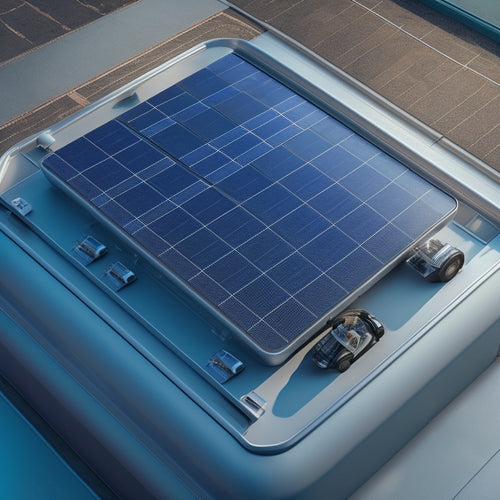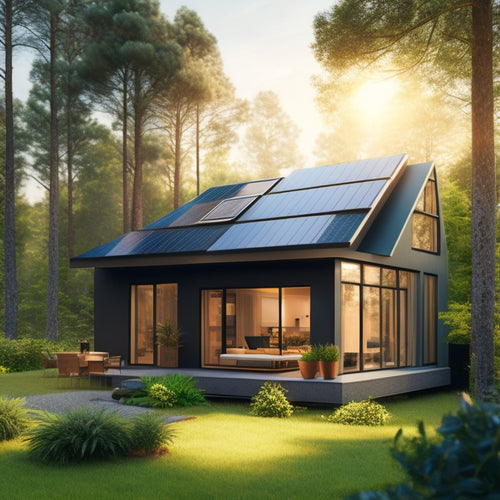
Designing Efficient Apartment Rooftop Systems: A Step-by-Step Guide
Share
When designing an efficient apartment rooftop system, you must assess the rooftop's structural integrity, environmental factors, and existing infrastructure. Evaluate the building's load-bearing capacity, weather patterns, and wind direction to guarantee durability. Select suitable solar panels with high efficiency ratings and consider factors like temperature coefficient and corrosion resistance. Configure panels for maximum energy production, optimize their orientation and spacing, and balance aesthetics with functionality. As you navigate the complexities of rooftop system design, you'll uncover the intricacies of creating a harmonious blend of functionality and aesthetics - and discover the key to ensuring a truly efficient rooftop system lies ahead.
Key Takeaways
• Assess apartment rooftop conditions, including structural integrity, load-bearing capacity, and environmental factors, to ensure a suitable base for the system.
• Select solar panels with high efficiency ratings (>20%) and consider temperature coefficient, durability, and resistance to corrosion for optimal energy generation.
• Design solar arrays that balance energy production with structural integrity, considering panel orientation, tilt, and spacing, as well as integration with other rooftop systems.
• Optimize rooftop space allocation by prioritizing systems, ensuring seamless integration, and designing for flexibility and future upgrades or replacements.
• Ensure compliance with local building codes, permits, and zoning regulations, and verify structural integrity through load capacity analysis and material selection.
Assessing Apartment Rooftop Conditions
As you prepare to design an efficient rooftop system, you must first evaluate the rooftop conditions, taking into account factors such as structural integrity, existing infrastructure, and environmental considerations. This important step guarantees that your rooftop system is tailored to the unique characteristics of your apartment building.
When evaluating rooftop conditions, pay attention to the structural integrity of the roof, including its load-bearing capacity and any potential weaknesses. Existing infrastructure, such as ventilation systems, pipes, and electrical conduits, must also be considered to avoid conflicts with your rooftop system. Environmental factors, like weather patterns and wind direction, will impact your system's performance and longevity.
Effective rooftop drainage is essential to prevent water accumulation, which can compromise the structure and lead to costly repairs. Weather resistance is another critical aspect, as it directly affects the system's durability and maintenance requirements.
Selecting Suitable Solar Panels
With your rooftop conditions assessed, you can now focus on selecting solar panels that will efficiently harness the sun's energy while withstanding the environmental stresses you've identified.
As you explore your options, prioritize panel efficiency, as it directly impacts energy output. Look for panels with high efficiency ratings, typically above 20%. This guarantees that more sunlight is converted into usable energy.
When evaluating panels, consider the temperature coefficient, which affects energy output in hot climates. A lower temperature coefficient means the panel will maintain its efficiency in high temperatures. Additionally, assess the panel's durability and resistance to corrosion, making sure it can withstand harsh weather conditions.
To maximize energy output, consider the panel's wattage and voltage ratings. Higher wattage panels can generate more energy, but may be larger and heavier. Balance energy output with space constraints and structural integrity.
Designing Efficient Solar Arrays
You'll need to configure your solar panels into an array that maximizes energy production while minimizing space usage and ensuring structural integrity. To achieve this, consider the following factors: panel orientation, tilt, and spacing.
A well-designed array should resemble a small-scale solar farm, with panels arranged to optimize energy output. Make sure that your array is compatible with the rooftop's structural capacity, taking into account wind loads, snow loads, and other environmental factors.
When designing your array, keep in mind that it will be integrated with other rooftop systems, such as green roofs. Guarantee that your solar array complements these systems, rather than competing with them for space.
Consider a ballasted system, which can be easily installed on rooftops without penetrating the membrane. This approach allows for easy removal and reinstallation during roof maintenance or replacement.
Optimizing Rooftop Space Allocation
To maximize the energy-generating potential of your rooftop, allocate space efficiently by balancing competing demands from various systems, including solar arrays, green roofs, and HVAC equipment. As you design your rooftop system, consider the trade-offs between these components to guarantee ideal space utilization.
Here are some key considerations to keep in mind:
-
Rooftop Aesthetics: Guarantee that your design balances functionality with visual appeal, as residents may use the rooftop for recreation or relaxation.
-
Space Utilization: Prioritize systems based on energy-generating potential, maintenance access, and weight distribution to maximize rooftop real estate.
-
System Interoperability: Ensure seamless integration between solar arrays, green roofs, and HVAC equipment to minimize conflicts and optimize performance.
- Future-Proofing: Design your rooftop system with flexibility in mind, allowing for easy upgrades or replacements as technology evolves.
Ensuring Structural Integrity Compliance
When designing an efficient apartment rooftop system, there are key considerations to keep in mind.
You'll need to verify that your structure can handle the weight and stress of various rooftop components. To do this, you'll need to conduct a thorough load capacity analysis.
Additionally, selecting materials that meet strict criteria and confirming that your design meets local building codes are essential steps in the process.
Load Capacity Analysis
As rooftop designers, conducting a thorough load capacity analysis is vital to guarantee that the rooftop system can withstand various external loads, including snow, wind, and dead loads, without compromising the structural integrity of the building. This analysis is essential in ensuring that your design meets the required building codes and regulations.
To ensure a detailed load capacity analysis, you should consider the following factors:
-
Structural dynamics: Analyze the rooftop system's response to dynamic loads, such as wind and seismic activity, to confirm it can withstand external forces.
-
Dead loads: Calculate the weight of the rooftop system's components, including the roofing material, insulation, and any additional features like green roofs or solar panels.
-
Live loads: Determine the maximum weight of people, furniture, and other objects that will be placed on the rooftop, ensuring the system can support the expected load.
- Environmental factors: Consider the impact of environmental conditions, such as temperature fluctuations, on the rooftop system's performance and durability.
Material Selection Criteria
You must meticulously evaluate the material selection criteria to guarantee the rooftop system's structural integrity, building upon the load capacity analysis to specify components that can withstand the calculated stresses and loads. This establishes that your design can resist various environmental factors, including wind, rain, and extreme temperatures.
When selecting materials, you should prioritize weather resistance to minimize maintenance and extend the system's lifespan. This involves choosing materials with inherent resistance to corrosion, decay, or degradation. For instance, using galvanized or stainless steel for structural components can provide excellent corrosion resistance.
Additionally, cost-effectiveness is important in material selection. You should balance the upfront cost of materials with their expected performance, durability, and maintenance requirements. A cost-benefit analysis can help you identify the most suitable materials that meet your design requirements while staying within budget constraints.
Code Compliance Checks
To comply with local building codes and regulations, it's important to conduct thorough code compliance checks to verify that your rooftop system design meets the required structural integrity standards. As you navigate the design process, it's vital to make sure that your system adheres to the necessary building permits and zoning regulations. Failure to comply can result in costly revisions, project delays, and even legal repercussions.
To guarantee a seamless compliance process, follow these steps:
-
Verify local building codes: Familiarize yourself with local building codes, ordinances, and regulations that govern rooftop system design and installation.
-
Obtain necessary permits: Secure all required building permits and approvals before commencing the project.
-
Conduct zoning reviews: Make sure that your rooftop system design complies with local zoning regulations, including height restrictions and setback requirements.
- Perform structural integrity checks: Confirm that your rooftop system design meets the required structural integrity standards, including load calculations and material specifications.
Meeting Local Building Codes
Adhering to local building codes is crucial, since rooftop system designs must follow jurisdictional regulations governing structural integrity, fire safety, and accessibility. You'll need to research and comply with local codes, ordinances, and zoning regulations to guarantee your design meets the required standards. Familiarize yourself with code exemptions, which may apply to specific system components or installations. For instance, some jurisdictions exempt certain solar panel systems from permit requirements.
When reviewing local building codes, pay attention to zoning regulations that dictate setbacks, height restrictions, and other spatial requirements. Ensure your design accommodates these constraints to avoid costly revisions or even project cancellation. You may need to consult with local authorities or a code consultant to clarify specific regulations.
Don't assume that a design compliant in one jurisdiction will automatically meet the codes in another. By understanding and adhering to local building codes, you'll establish a safe, functional, and compliant rooftop system that meets the needs of residents and building owners.
Choosing Solar Panel Installation Software
Selecting the right solar panel installation software is pivotal in ensuring accurate system design, streamlined permitting, and efficient project management. As you begin designing an efficient apartment rooftop system, choosing the right software is essential. A good software comparison is important to identify the best fit for your project.
When evaluating software, consider the following key factors:
-
Compliance with industry standards: Make sure the software adheres to industry standards, such as NEC and UL, to guarantee compliance with local building codes.
-
System design and simulation capabilities: Look for software that can accurately simulate system performance and provide detailed design reports.
-
Permitting and inspection tools: Opt for software that streamlines the permitting process and provides tools for efficient inspection and commissioning.
- Integration with existing workflow: Choose software that seamlessly integrates with your existing workflow and tools to minimize disruptions.
Creating Accurate System Designs
When creating accurate system designs for your apartment rooftop system, you'll need to pinpoint the essential system requirements and assess the available roof space.
This involves identifying the specific energy needs of the building and determining the best system size and layout.
System Requirements Analysis
To create an efficient rooftop system, you must first identify the specific requirements of your apartment building, including its unique climate, occupancy patterns, and energy efficiency goals. This involves defining the system boundaries, which encompass the physical limits of your rooftop system, as well as the performance metrics that will be used to evaluate its success.
To conduct a thorough system requirements analysis, consider the following key factors:
-
Climate and weather patterns: How will local weather conditions impact your rooftop system's performance?
-
Occupancy patterns and schedules: How will the building's occupancy patterns affect energy demand and system performance?
-
Energy efficiency goals and targets: What're the building's energy efficiency goals, and how will they be measured and achieved?
- System integration and interfaces: How will your rooftop system integrate with existing building systems, and what interfaces will be required?
Roof Space Assessment
With your system requirements defined, you can now assess the rooftop space to create an accurate design that meets your building's unique needs and constraints. This step is vital in ensuring your rooftop system is efficient and effective.
Start by identifying roof constraints, such as limited space, structural limitations, and existing rooftop features like skylights or vents. Take precise measurements of the rooftop area, including any obstacles or hidden obstructions that could impact your design.
Consider factors like wind direction, sunlight exposure, and drainage patterns to determine the best layout for your system. Be meticulous in your assessment, as even small oversights can lead to costly mistakes down the line.
Maximizing Energy Output Potential
You can greatly enhance your rooftop system's energy output potential by strategically orienting and spacing photovoltaic panels to minimize shading and optimize exposure to direct sunlight. This is important for maximizing energy harvesting and making sure your renewable solutions are efficient.
To take it a step further, consider the following strategies to boost your energy output:
-
Optimize panel angle and tilt: Adjust the angle and tilt of your panels to match the seasonal changes in sunlight patterns.
-
Minimize obstacles: Make sure that nearby structures or objects don't cast shadows on your panels, reducing energy output.
-
Cleanliness matters: Regularly clean your panels to remove dirt and debris that can reduce energy production.
- Monitor and adjust: Continuously monitor your system's performance and make adjustments as needed to optimize energy output.
Performing Thorough System Inspections
As you prepare to inspect your apartment rooftop system, you'll want to conduct a thorough assessment to identify areas for improvement.
Start by creating a visual inspection checklist to make sure you're covering all critical components, from piping and wiring to equipment and structural integrity.
Rooftop System Assessment
Performing a thorough rooftop system assessment requires inspecting all components, including roofing materials, drainage systems, and mechanical equipment, to identify potential issues and opportunities for improvement. As you initiate this essential step, remember that a detailed assessment is key to designing an efficient apartment rooftop system.
To guarantee a thorough assessment, consider the following essential aspects:
-
Rooftop Hazards: Identify potential hazards such as tripping hazards, fall risks, and other safety concerns that could impact the system's performance and maintenance.
-
System Auditing: Conduct an in-depth review of the existing system, including its design, installation, and maintenance history, to identify areas for improvement.
-
Component Condition: Inspect the condition of all components, including roofing materials, pipes, and mechanical equipment, to identify signs of wear, damage, or deterioration.
- Code Compliance: Verify that the rooftop system complies with local building codes, regulations, and industry standards to ensure a safe and efficient operation.
Visual Inspection Checklist
To guarantee a thorough visual inspection, create a detailed checklist that accounts for every rooftop system component, from roofing materials and drainage systems to mechanical equipment and accessories. This will make sure you don't miss any critical areas that could lead to rooftop hazards. As you inspect, pay attention to signs of wear, damage, or corrosion on components, as well as any evidence of leaks, water damage, or pest infestations.
When creating your checklist, consider the inspection frequency for each component. Some items, like HVAC units, may require more frequent inspections than others, like roofing membranes. Be sure to include a schedule for regular inspections to stay on top of maintenance and prevent issues from escalating.
Remember to also inspect rooftop accessories, such as skylights, vents, and antennas, which can be prone to damage or obstruction.
Frequently Asked Questions
Can Existing Rooftop Infrastructure Support Solar Panel Installations?
As you step into the rooftop oasis, the question looms: can your existing infrastructure support solar panels? To find out, you'll need to assess the structural integrity of your roof, conducting a thorough roof assessment to determine its capacity to bear the added weight.
How Do I Handle Potential Roof Leaks After Solar Panel Installation?
To mitigate potential roof leaks after solar panel installation, you'll want to make sure a waterproof membrane is properly applied, and consider investing in leak detection systems to quickly identify and address any issues that arise.
Are There Any Tax Incentives for Apartment Rooftop Solar Systems?
You can benefit from various incentives for your apartment rooftop solar system, including Federal Grants, State Rebates, and Local Exemptions, as well as Renewable Credits, which can greatly reduce your overall cost and increase your ROI.
Can I Install Solar Panels on a Rooftop With Skylights or Vents?
You'll need to assess rooftop accessibility and structural integrity before installing solar panels around skylights or vents, ensuring a secure and efficient system that integrates seamlessly with your rooftop's unique features.
Do Solar Panels Increase the Value of an Apartment Building?
You're likely to boost your apartment building's value by installing solar panels, as they enhance its green credentials, making it more attractive to eco-conscious buyers who value sustainability, as shown on popular Property Apps.
Related Posts
-

Top Solar Panels for Car Battery Maintenance
When selecting top solar panels for car battery maintenance, consider high-efficiency models with high wattage output...
-

Why Cities Need Smart Charging Infrastructure Now
You're about to experience a tidal wave of electric vehicles hitting your city's streets, and it's essential you're p...
-

Reduce Solar Panel Cost for Your Small Home
By evaluating your energy needs, choosing the right installer, and selecting cost-effective solar panel options, you ...


